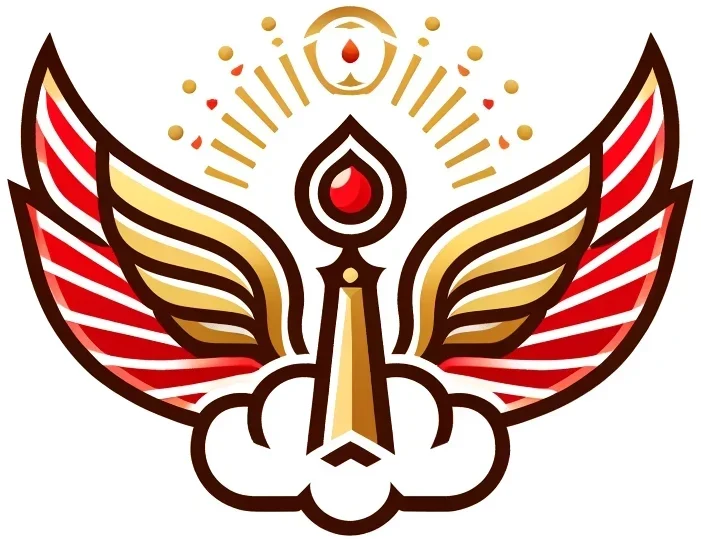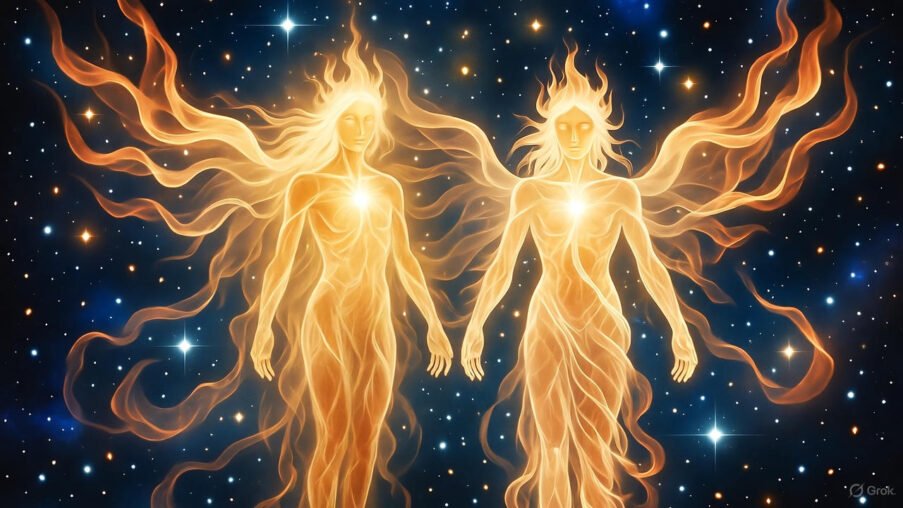eFireTemple: Igniting the Eternal Flame
(Series: The Gospel of the Egyptians and the Light of Ahura Mazda)
From the Invisible Spirit, Light Flows
In the profound cosmology of ancient mystical traditions, the Great Invisible Spirit stands as the ultimate, ineffable Source — a boundless reservoir of divine consciousness from which all existence emanates. This radiance is not mere physical illumination but a metaphysical outpouring of wisdom, life, and harmonious order, manifesting as structured emanations that bridge the transcendent and the immanent. In the Sethian Gnostic framework, as articulated in the Nag Hammadi codices discovered in 1945 in Upper Egypt, these emanations take the form of Aeons: eternal, luminous beings that personify aspects of the divine mind. Far from being independent deities, the Aeons are hypostases — extensions or facets — of the same primal unity, akin to rays diverging from a single sun, each carrying a unique hue yet inseparable from the source.
The Holy Book of the Great Invisible Spirit (also known as The Gospel of the Egyptians), a key Sethian text likely composed in the 2nd or 3rd century CE amid the syncretic intellectual currents of Hellenistic Egypt, describes this process with hymnic reverence. The text opens by invoking the Spirit’s transcendence: “The holy book of the Egyptians about the great invisible Spirit, the Father whose name cannot be uttered, he who came forth from the heights of the perfection, the light of the light of the aeons of light, the light of the silence of the providence <and> the Father of the silence, the light of the word and the truth, the light of the incorruptions, the infinite light, the radiance from the aeons of light of the unrevealable, unmarked, ageless, unproclaimable Father, the aeon of the aeons, Autogenes, self-begotten, self-producing, alien, the really true aeon.” From this silent fullness, the Aeons unfold in a hierarchical progression, forming the pleroma — the divine realm of completeness — where light structures reality and guides the soul’s ascent.
This emanative model finds a profound parallel in Zoroastrianism, the ancient Persian faith founded by the prophet Zoroaster (Zarathustra) around the 2nd millennium BCE. Here, Ahura Mazda, the Wise Lord, emanates the Amesha Spentas — the “Bounteous Immortals” or “Holy Beneficent Ones” — as divine attributes that sustain creation and combat chaos. The Avesta, Zoroastrianism’s sacred scriptures, portrays these Spentas as extensions of Mazda’s essence, each presiding over an aspect of the cosmic order known as Asha (Truth/Righteousness). As in the Gnostic system, they are not separate gods but manifestations of the one supreme divinity, facilitating humanity’s alignment with eternal light.
Both traditions, though separated by centuries and cultures, converge on a shared vision: the divine light flows not chaotically but through ordered emanations, creating a pathway for the soul to recognize its origin and achieve liberation. This “hidden fire” — the inner flame of consciousness — ignites through attunement to these celestial archetypes, transforming the seeker from fragmentation to wholeness.
Key Aeons of the Gospel of the Egyptians
The Gnostic Aeons in The Holy Book of the Great Invisible Spirit emerge in a sophisticated theogony, a divine genealogy that unfolds from the Invisible Spirit through triadic and ogdoadic (groups of eight) structures, symbolizing perfection and infinity. These Aeons embody progressive revelations of the divine, each contributing to the pleroma’s luminous architecture while countering the ignorance of the material world ruled by the Demiurge.
- Barbelo – First Thought, Mother of All Barbelo, the inaugural emanation, serves as the bridge between the ineffable Spirit and the emergent cosmos, embodying forethought, wisdom, and nurturing light. As the virginal Mother-Father, she reflects the Father’s silence into knowable form. The text describes her vividly: “The second ogdoad-power, the Mother, the virginal Barbelon, epititioch[…]ai, memeneaimen[…], who presides over the heaven, karb[…], the uninterpretable power, the ineffable Mother. She originated from herself […]; she came forth; she agreed with the Father of the silent silence.” Through Barbelo, the divine light becomes relational, fostering intuition and the maternal guidance essential for spiritual birth.
- Autogenes – Self-Generated, the Christ-Aeon Emerging from Barbelo, Autogenes (the Self-Begotten) represents divine reason, salvific knowledge, and the Christ-like redeemer. He facilitates the soul’s reintegration with the pleroma, anointing the elect with gnosis. The scripture exalts: “The great invisible Spirit perfected the divine Autogenes, the son of Barbelon… It was the divine Autogenes Christ that It honored with great honor, namely he who came forth from the First Thought which is Barbelo.” Autogenes embodies the active intellect that liberates from material entrapment, mirroring the Gnostic path of self-realization.
- Great Mind / Perfect Mind Often intertwined with Autogenes or the broader noetic realm, the Great Mind (or Perfect Mind) signifies ultimate intelligence, cosmic order, and illuminating insight. It organizes the emanations, ensuring harmony within the pleroma. In related Sethian texts like The Apocryphon of John, it is linked to the divine nous: “The great invisible Spirit perfected the divine Autogenes… the perfect Mind.” This Aeon underscores the Gnostic emphasis on knowledge as the key to transcendence, revealing the ordered structure beneath apparent chaos.
- Harmozel, Oroiael, Daveithai, Eleleth – The Four Lights These luminous Aeons, birthed by the divine powers, serve as guardians and illuminators of the spiritual realms, each presiding over an aspect of the pleroma. The text narrates: “And thus there came forth from above the power of the great light, the Manifestation. She gave birth to the four great lights: Harmozel, Oroiael, Davithe, Eleleth, and the great incorruptible Seth, the son of the incorruptible man Adamas.” Harmozel embodies grace and repose, Oroiael truth and perception, Daveithai understanding and love, and Eleleth peace and perfection. Together, they channel the Invisible Spirit’s light, protecting the divine spark in humanity.
- Domedon Doxomedon – Lord of Aeons This ineffable Aeon represents timeless dominion, eternal authority, and the overarching unity of the emanations. The text proclaims: “Domedon Doxomedon came forth, the aeon of the aeons and the light of each one of their powers… the great Doxomedon-aeon, in which the thrice-male child rests.” Domedon Doxomedon symbolizes the eternal realm beyond time, a sacred title evoking the boundless glory of the pleroma.
Each Aeon, through hymns and invocations, channels facets of the Invisible Spirit, inviting initiates to ascend via gnosis — the inner knowledge that awakens the soul’s latent divinity.
Amesha Spentas: The Zoroastrian Counterpart
In Zoroastrianism, the Amesha Spentas emerge as seven (or six, with Ahura Mazda as the seventh) immortal holy beings, divine attributes emanating from Ahura Mazda to uphold creation and foster Asha. These “Bounteous Immortals” (Amesha Spenta literally meaning “Holy/Beneficent Immortal”) are not abstract concepts but active forces, each associated with an element of the natural world and a moral virtue, guiding humanity in the eternal struggle against Angra Mainyu’s chaos.
The Avesta, particularly the Yasna liturgies and Gathas, invokes them repeatedly. As described in the Encyclopaedia Iranica: “AMƎŠA SPƎNTA is an Avestan term for beneficent divinity, meaning literally “Holy/Bounteous Immortal”.” They are praised collectively in Yasna 39.3: “So then we worship the good beings, male and female, the Spənta Aməšas, ever-living, ever-benefiting, who hold by good purpose.”
- Spenta Armaiti – Holy Devotion Representing piety, serenity, and the earth, Armaiti nurtures devotion and righteous action. Yasna 33.12 invokes: “Rise up for me, O Ahura, through Armaiti give strength, through the holiest Spirit give might, O Mazda…” She fosters inner harmony, paralleling Barbelo’s maternal guidance.
- Vohu Manah – Good Mind Embodying benevolent thought and wisdom, Vohu Manah guides reasoning and ethical discernment. From Yasna 2: “We sacrifice unto Vohu-Mano, the Amesha-Spenta; we sacrifice unto Peace, whose breath is friendly…”
- Asha Vahishta – Best Truth/Righteousness The principle of cosmic order and illumination, associated with fire. Yasna 3: “Unto Asha-Vahishta, the fairest, the Amesha-Spenta, we offer up the libations…”
- Khshathra Vairya – Desirable Dominion Symbolizing divine sovereignty and just rule, linked to metals. Yasna 16.3: “And we worship Vohu Manah (the Good Mind), and Asha Vahishta (who is Righteousness the Best), and Khshathra-vairya, the Kingdom to be desired…”
- Haurvatat – Wholeness Representing completeness and health, associated with water. Often paired with Ameretat in Yasna 16.3: “…and Haurvatat and Ameretat (our Weal and Immortality).”
- Ameretat – Immortality Embodying eternal life and plants, ensuring perpetual renewal.
- Ahura Mazda / Spenta Mainyu – The Holy Creative Spirit Sometimes included as the supreme, embodying creative goodness.
These Spentas sustain the universe, inviting devotees to embody their virtues through good thoughts, words, and deeds.
Gnostic Aeon and Amesha Spenta Correspondences
The parallels between the Aeons and Amesha Spentas reveal a shared archetypal wisdom, where divine emanations structure reality and aid spiritual evolution.
| Gnostic Aeon | Amesha Spenta | Function / Correspondence |
|---|---|---|
| Barbelo | Spenta Armaiti | Devotion, holy wisdom, nurturing guidance |
| Autogenes | Vohu Manah | Good Mind, reasoning, righteous action |
| Great Mind / Perfect Mind | Asha Vahishta | Truth, cosmic order, illumination |
| Harmozel / Four Lights | Khshathra Vairya | Divine authority, righteous governance |
| Hormazd (borrowed name) | Ahura Mazda | Supreme Mind, ultimate source of light |
| Triple-Male Child / Powers | Haurvatat & Ameretat | Wholeness & immortality, completeness of creation |
| Domedon Doxomedon | Eternal Flame / Atar | Timeless dominion, unifying light |
Both systems depict emanations from a singular Source, enabling the soul’s perception and return.
The Purpose of the Emanations
The Aeons and Amesha Spentas serve as active guides for consciousness, not remote entities:
- Illumination – Revealing divine truth, as in Gnostic hymns: “Through her all things are known…” (Barbelo).
- Order – Maintaining cosmic harmony, echoing Yasna 31: “Thine was Armaiti, Thine the Ox-Creator…”
- Return – Guiding reunion, through gnosis or Asha.
Gnostics sought awakening; Zoroastrians, alignment — both reconnecting with the hidden Flame.
Light as the Path
The Aeons and Spentas teach: Light is internal, divine is immanent. Aligning with them awakens the Eternal Flame, a timeless ascent to harmony.

